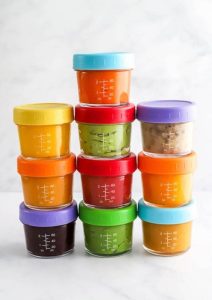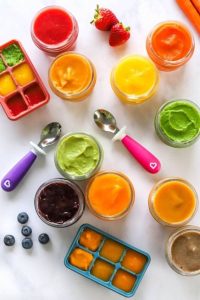Starting fruit and vegetable puree is a thrilling and messy milestone! This new stage brings exploration, discovery, and a whole new world of flavors for them to experience. Starting with smooth purees is a fantastic way to begin this journey.
Purees made from fruits and vegetables are a nutritious and delicious first step for babies. They are easy to swallow and digest, and they expose babies to a variety of tastes and textures. In this article, we’ll explore everything you need to know about introducing fruit and vegetable purees to your baby.
When is My Baby Ready for Solid Foods?
Every baby develops at their own pace. There’s no single right time to introduce solid foods. However, there are some general signs that your baby might be ready to explore purees. These include:
- Your baby is around 6 months old.
- They can hold their head up steadily.
- They show interest in your food and try to grab it.
- They can move food from the front to the back of their tongue with their tongue.
If you’re unsure if your baby is ready for solids, talk to your doctor or pediatrician. They can help you decide the best time to start.
Choosing the Perfect First Fruits and Vegetables
When starting fruit and vegetable puree for your baby, there are a few things to consider. Here are some tips:
Start with mild flavors:
Sweet potatoes, apples, pears, and avocado are all naturally sweet and easy for babies to accept.
Opt for single-ingredient purees at first:
This way, you can easily identify any potential allergies.
Choose organic whenever possible:
This helps reduce exposure to pesticides.
Variety is key:
Once your baby has tried a few single-ingredient purees, you can start introducing them to combinations of fruits and vegetables.
Here are some examples of great first-choice fruits and vegetables:
- Sweet potatoes
- Apples
- Pears
- Avocado
- Note that avocado is a high-fat food. Start with a small amount at first.
- Bananas
- Mangoes
- Green beans
- Peas
- Butternut squash
Making Your Own Purees vs. Buying Pre-Made
There are pros and cons to both starting fruit and vegetable puree and buying pre-made ones. Consider these factors when making your decision:
- Making your own purees: This allows you to control exactly what goes into your baby’s food. It’s also a fun way to get creative with flavors. However, it can be time-consuming.
- Buying pre-made purees: Pre-made purees are convenient and shelf-stable. They’re a great option for busy parents. However, they may not be as fresh as homemade purees, and they may contain added sugars or preservatives.
No matter which option you choose, be sure to read the labels carefully. Choose purees that are appropriate for your baby’s age and don’t contain added sugar, salt, or thickeners.
Creating Delicious and Nutritious Purees at Home
Making your own purees is a simple process. Here’s what you’ll need:
- A steamer or pot
- A blender or food processor
- Silicone ice cube trays (optional)
Here are the basic steps for making purees:
- Wash and peel the fruits or vegetables.
- Steam or cook the fruits or vegetables until soft.
- Let the fruits or vegetables cool slightly.
- Puree the fruits or vegetables in a blender or food processor until smooth.
- Add a little breast milk, formula, or water to thin the puree to the desired consistency.
Here are some additional tips for making purees:
- You can freeze leftover puree in silicone ice cube trays for easy portion control.
- Once your baby is a little older, you can experiment with different textures by adding a little mash to the puree.
- Get creative! There are endless combinations of fruits and vegetables you can try.
Feeding Purees to Your Baby
Mealtime with your baby should be a relaxed and enjoyable experience. Here are some tips for feeding purees to your baby:
- Sit your baby in a highchair in an upright position.
- Use a spoon to feed your baby small amounts of puree at a time.
- Let your baby take their time and pace themselves.
- It’s okay if your baby doesn’t eat everything you offer them. They may just be getting used to the new experience.
- Avoid forcing your baby to eat or cleaning their face aggressively.
Beyond the Spoon: Encouraging Self-Feeding with Purees
As your baby gets older and their coordination improves, you can encourage self-feeding with purees. Here are some ideas:
- Finger foods: Once your baby is around 8-9 months old, you can offer them thicker purees or mashed fruits and vegetables as finger foods. This will help them develop their hand-eye coordination and self-feeding skills. Start with large, soft pieces that are easy for them to grasp and gum.
- Spoon practice: Provide your baby with a soft-tipped spoon and let them experiment with feeding themselves. It will be messy at first, but it’s an important part of learning to eat independently.
Safety tip: Always supervise your baby closely during mealtimes to prevent choking.
The Takeaway: Starting Solids with Confidence
Introducing your baby to solid foods is an exciting adventure. By following these tips and starting with fruit and vegetable purees, you can set your baby up for a healthy relationship with food.
Remember: Every baby develops at their own pace. Be patient, have fun, and enjoy this special time of discovery!
Building a Healthy Relationship with Food: Mealtime Tips for Introducing Purees
Introducing solid foods is a significant milestone in your baby’s development. It’s a chance to establish positive habits around mealtimes and food exploration. Here are some tips to create a relaxed and enjoyable experience for you and your baby:
-
Make mealtime a social event: Sit down with your baby and chat with them during feeding times. This helps create positive associations with food.
-
Follow your baby’s cues: Pay attention to your baby’s hunger and fullness signals. Start feeding when they seem interested and stop when they turn away or fuss.

-
Let your baby explore: Purees can be a fun way for your baby to get messy and experiment with textures. Provide a spoon for them to self-feed as their coordination develops.
-
Variety is key: Once your baby has enjoyed a few basic purees, branch out and offer a variety of colors, tastes, and textures. This helps expose them to a wide range of nutrients and flavors.
-
Be patient: It takes time for babies to adjust to new flavors and textures. Don’t be discouraged if your baby rejects a puree at first. Offer it again another time and be persistent but gentle.
By following these tips, you can help your baby develop a healthy relationship with food from the very beginning. Remember, mealtimes should be a positive and enjoyable experience for both you and your baby.




